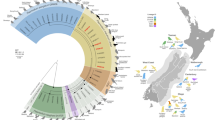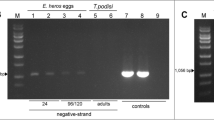Abstract
Proventriculus and intestinal samples from 70 North American red-winged blackbirds (Agelaius phoeniceus; order Passeriformes) were examined for the presence of Cryptosporidium by PCR amplification and sequence analysis of the 18S ribosomal RNA (18S rRNA), actin, and 70-kDa heat shock protein (HSP70) genes. Twelve birds (17.1 %) were positive for the Cryptosporidium 18S rRNA gene: six birds were positive at the proventriculus site only and six birds were positive at the proventriculus and intestinal sites. Sequence analysis of the 18S rRNA, actin and HSP70 genes showed the presence of the gastric species Cryptosporidium galli in a single proventriculus sample and a closely related genotype, which we have named Cryptosporidium avian genotype VI, in all other positive samples. These findings contribute to our understanding of Cryptosporidium diversification in passerines, the largest avian order.


Similar content being viewed by others
References
Ball RM, Freeman S, James FC, Bermingham E, Avise JC (1988) Phylogeographic population structure of red-winged blackbirds assessed by mitochondrial DNA. Proc Natl Acad Sci U S A 85:1558–1562
Blagburn BL, Lindsay DS, Hoerr FJ, Atlas AL, Toivio-Kinnucan M (1990) Cryptosporidium sp. infection in the proventriculus of an Australian diamond firetail finch (Staganoplura bella: Passeriformes, Estrildidae). Avian Dis 34:1027–1030
Checkley W, White AC Jr, Jaganath D, Arrowood MJ, Chalmers RM, Chen XM, Fayer R, Griffiths JK, Guerrant RL, Hedstrom L, Huston CD, Kotloff KL, Kang G, Mead JR, Miller M, Petri WA Jr, Priest JW, Roos DS, Striepen B, Thompson RC, Ward HD, Van Voorhis WA, Xiao L, Zhu G, Houpt ER (2015) A review of the global burden, novel diagnostics, therapeutics, and vaccine targets for Cryptosporidium. Lancet Infect Dis 15:85–94
Current WL, Upton SJ, Haynes TB (1986) The life cycle of Cryptosporidium baileyi n. sp. (Apicomplexa, Cryptosporidiidae) infecting chickens. J Protozool 33:289–296
Feltus DC, Giddings CW, Schneck BL, Monson T, Warshauer D, McEvoy JM (2006) Evidence supporting zoonotic transmission of Cryptosporidium spp. in Wisconsin. J Clin Microbiol 44:4303–4308
Gomes RS, Huber F, da Silva S, do Bomfim TC (2012) Cryptosporidium spp. parasitize exotic birds that are commercialized in markets, commercial aviaries, and pet shops. Parasitol Res 110:1363–1370
Katoh K, Standley DM (2013) MAFFT multiple sequence alignment software version 7: improvements in performance and usability. Mol Biol Evol 30:772–780
Koonin EV (2005) Orthologs, paralogs, and evolutionary genomics. Annu Rev Genet 39:309–338
Kváč M, McEvoy J, Stenger B, Clark M (2014) Cryptosporidiosis in other vertebrates. In: Cacciò SM, Widmer G (eds) Cryptosporidium: parasite and disease. Springer Vienna, Vienna, Austria, pp 237–323
Le Blancq SM, Khramtsov NV, Zamani F, Upton SJ, Wu TW (1997) Ribosomal RNA gene organization in Cryptosporidium parvum. Mol Biochem Parasitol 90:463–478
Ley DH, Moresco A, Frasca S Jr (2012) Conjunctivitis, rhinitis, and sinusitis in cliff swallows (Petrochelidon pyrrhonota) found in association with Mycoplasma sturni infection and cryptosporidiosis. Avian Pathol 41:395–401
Lowther PE (1975) Geographic and ecological variation in family Icteridae. Wilson Bull 87:481–495
Makino I, Abe N, Reavill DR (2010) Cryptosporidium avian genotype III as a possible causative agent of chronic vomiting in peach-faced lovebirds (Agapornis roseicollis). Avian Dis 54:1102–1107
Morgan UM, Monis PT, Xiao L, Limor J, Sulaiman I, Raidal S, O’Donoghue P, Gasser R, Murray A, Fayer R, Blagburn BL, Lal AA, Thompson RC (2001) Molecular and phylogenetic characterisation of Cryptosporidium from birds. Int J Parasitol 31:289–296
Nakamura AA, Simoes DC, Antunes RG, da Silva DC, Meireles MV (2009) Molecular characterization of Cryptosporidium spp. from fecal samples of birds kept in captivity in Brazil. Vet Parasitol 166:47–51
Nakamura AA, Homem CG, da Silva AM, Meireles MV (2014) Diagnosis of gastric cryptosporidiosis in birds using a duplex real-time PCR assay. Vet Parasitol 205:7–13
Ng J, Pavlásek I, Ryan U (2006) Identification of novel Cryptosporidium genotypes from avian hosts. Appl Environ Microbiol 72:7548–7553
Qi M, Wang R, Ning C, Li X, Zhang L, Jian F, Sun Y, Xiao L (2011) Cryptosporidium spp. in pet birds: genetic diversity and potential public health significance. Exp Parasitol 128:336–340
Ryan U (2010) Cryptosporidium in birds, fish and amphibians. Exp Parasitol 124:113–120
Ryan U, Xiao L, Read C, Zhou L, Lal AA, Pavlásek I (2003a) Identification of novel Cryptosporidium genotypes from the Czech Republic. Appl Environ Microbiol 69:4302–4307
Ryan UM, Xiao L, Read C, Sulaiman IM, Monis P, Lal AA, Fayer R, Pavlásek I (2003b) A redescription of Cryptosporidium galli Pavlásek, 1999 (Apicomplexa: Cryptosporidiidae) from birds. J Parasitol 89:809–813
Saitou N, Nei M (1987) The neighbor-joining method: a new method for reconstructing phylogenetic trees. Mol Biol Evol 4:406–425
Sevá Ada P, Funada MR, Richtzenhain L, Guimarães MB, Souza SO, Allegretti L, Sinhorini JA, Duarte VV, Soares RM (2011) Genotyping of Cryptosporidium spp. from free-living wild birds from Brazil. Vet Parasitol 175:27–32
Slavin D (1955) Cryptosporidium meleagridis (sp. nov.). Journal of Comparitive Pathology 65:262–266
Stenger BL, Clark ME, Kváč M, Khan E, Giddings CW, Dyer NW, Schultz JL, McEvoy JM (2015) Highly divergent 18S rRNA gene paralogs in a Cryptosporidium genotype from eastern chipmunks (Tamias striatus). Infect Genet Evol 32:113–123
Sulaiman IM, Lal AA, Xiao L (2002) Molecular phylogeny and evolutionary relationships of Cryptosporidium parasites at the actin locus. J Parasitol 88:388–394
Tamura K (1992) Estimation of the number of nucleotide substitutions when there are strong transition-transversion and G + C-content biases. Mol Biol Evol 9:678–687
Tamura K, Stecher G, Peterson D, Filipski A, Kumar S (2013) MEGA6: Molecular Evolutionary Genetics Analysis version 6.0. Mol Biol Evol 30:2725–2729
Tavaré S (1986) Some probabilistic and statistical problems in the analysis of DNA sequences. In: Miura RM (ed) Some mathematical questions in biology: DNA sequence analysis (lectures on mathematics in the life sciences). American Mathematical Society, New York, pp 57–86
Xiao L, Singh A, Limor J, Graczyk TK, Gradus S, Lal A (2001) Molecular characterization of Cryptosporidium oocysts in samples of raw surface water and wastewater. Appl Environ Microbiol 67:1097–1101
Xiao L, Fayer R, Ryan U, Upton SJ (2004) Cryptosporidium taxonomy: recent advances and implications for public health. Clin Microbiol Rev 17:72–97
Yasukawa K, Searcy WA (1995) Red-winged blackbird (Agelaius phoeniceus). In: Poole A (ed) The birds of North America online. Cornell Laboratory of Ornithology, Ithaca, New York
Acknowledgments
The authors gratefully acknowledge support from USDA National Institute of Food and Agriculture (project number: 2008-35102-19260).
Author information
Authors and Affiliations
Corresponding author
Rights and permissions
About this article
Cite this article
Chelladurai, J.J., Clark, M.E., Kváč, M. et al. Cryptosporidium galli and novel Cryptosporidium avian genotype VI in North American red-winged blackbirds (Agelaius phoeniceus). Parasitol Res 115, 1901–1906 (2016). https://doi.org/10.1007/s00436-016-4930-8
Received:
Accepted:
Published:
Issue Date:
DOI: https://doi.org/10.1007/s00436-016-4930-8




